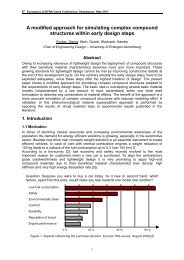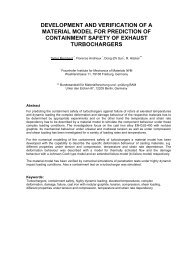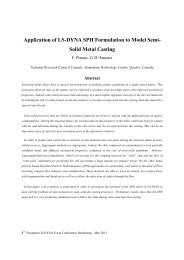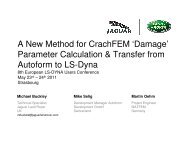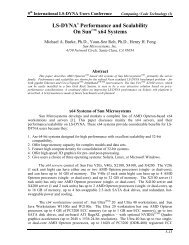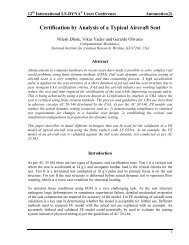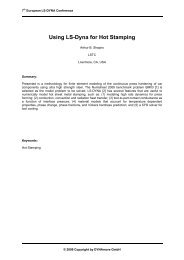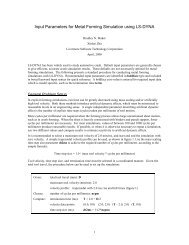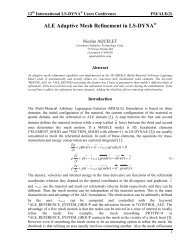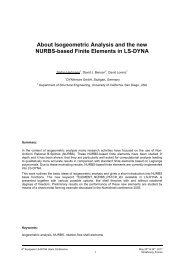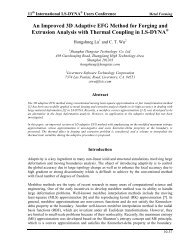Development of a thorax finite element model for ... - DYNAlook
Development of a thorax finite element model for ... - DYNAlook
Development of a thorax finite element model for ... - DYNAlook
You also want an ePaper? Increase the reach of your titles
YUMPU automatically turns print PDFs into web optimized ePapers that Google loves.
all launcher and the COUGAR launcher use a pyrotechnic system to impart energy to the<br />
projectile. The flash ball projectile similar to the squash ball is a de<strong>for</strong>mable projectile as well<br />
as the bliniz projectile (COUGAR). The FN 303 weapon uses a compressed air system and a<br />
thin stabilized projectile which breaks generally at impact.<br />
KENLW projectiles are low-mass (8g - 140 g) and the high-velocity (15 m/s – 250 m/s)<br />
projectiles as opposed to the automotive crash tests field where mass are higher and velocities<br />
lower (Fig. 2).<br />
Figure 1: Example <strong>of</strong> KENLW weapons and different projectile types<br />
To avoid the risk <strong>of</strong> penetration wounding at impact, KENLW projectiles are designed in such<br />
a way that the primary and desired effect is blunt trauma.<br />
Figure 2: Differences in mass and velocity <strong>for</strong> automotive collisions and ‘non-lethal’ ballistic<br />
impacts on a logarithmic scale [2]<br />
These differences between the KENLW ballistic impacts and the crash tests impacts are<br />
reflected in the biomechanical responses <strong>of</strong> the human body [5] although some injury<br />
mechanisms are similar. In this paper thoracic impacts will be considered. The reasons are<br />
threefold:<br />
Besides the human head which is not considered as a target in KENLW field because<br />
<strong>of</strong> the low tolerance level <strong>of</strong> the eyes, the <strong>thorax</strong> encompasses vital organs <strong>of</strong> the body and<br />
represents a wide surface <strong>of</strong> the body where the hit probability is great;<br />
It has been reported [5] that thoracic injuries represented 50% <strong>of</strong> casualties among the<br />
fatal casualties related to some type <strong>of</strong> chest trauma;<br />
There are experimental data on Post Mortem Human Subjects (PMHS) available in the<br />
open literature <strong>for</strong> thoracic impacts [5]. Those data were used <strong>for</strong> validation purpose <strong>of</strong> the<br />
<strong>thorax</strong> <strong>finite</strong> <strong>element</strong> <strong>model</strong> (FEM) that has been developed. Force-time and deflection-time<br />
8th European LS-DYNA Users Conference, Strasbourg - May 2011



